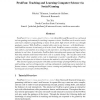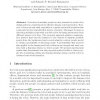1338 search results - page 129 / 268 » Understanding Social Robots |
CSEE
2011
Springer
13 years 1 months ago
2011
Springer
Pex4Fun (http://www.pexforfun.com/)from Microsoft Research is a web-based serious gaming environment for teaching computer science. Pex4Fun can be used to teach and learn computer...
CIARP
2007
Springer
14 years 4 months ago
2007
Springer
In order to deploy mobile robots in social environments like indoor buildings, they need to be provided with perceptual abilities to detect people. In the computer vision literatur...
IBERAMIA
2010
Springer
13 years 8 months ago
2010
Springer
Detection of multiple people is a key element for social robot design and it is a requirement for effective human-robot interaction. However, it is not an easy task, especially in...
ICRA
2007
IEEE
14 years 4 months ago
2007
IEEE
–This paper presents a novel affect-sensitive human-robot interaction framework for rehabilitation of children with autism spectrum disorder (ASD). The overall aim is to enable t...
AAAI
2008
14 years 19 days ago
2008
Spatial scaffolding is a naturally occurring human teaching behavior, in which teachers use their bodies to spatially structure the learning environment to direct the attention of...



